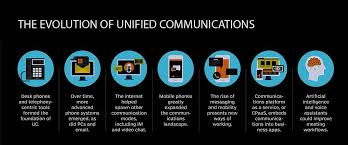The Power of Unified Communications for Enterprise
In today’s fast-paced business environment, effective communication is key to success. Enterprises are constantly seeking ways to streamline their communication processes and enhance collaboration among teams. This is where unified communications come into play.
Unified communications integrate various communication tools and channels into a single platform, providing employees with a unified experience across voice, video, messaging, and other mediums. By consolidating these tools, enterprises can improve efficiency, productivity, and overall business performance.
Benefits of Unified Communications for Enterprise:
- Enhanced Collaboration: Unified communications enable seamless collaboration among team members, regardless of their location or device. This leads to faster decision-making and improved project outcomes.
- Increased Productivity: By centralising communication tools, employees can easily access the information they need and communicate more efficiently. This reduces time wasted on switching between different platforms.
- Cost Savings: Consolidating communication systems can lead to cost savings for enterprises. By investing in a unified communications solution, businesses can eliminate the need for multiple subscriptions and reduce maintenance costs.
- Improved Customer Service: Unified communications enable employees to respond to customer inquiries more quickly and effectively. This leads to higher customer satisfaction levels and improved customer retention.
Implementing Unified Communications in Your Enterprise:
When implementing unified communications in your enterprise, it is essential to consider your specific business needs and goals. Conduct a thorough assessment of your current communication systems and identify areas that could benefit from consolidation.
Select a unified communications provider that offers a comprehensive solution tailored to your enterprise requirements. Ensure that the platform is scalable, secure, and user-friendly to encourage adoption among employees.
Training and support are crucial aspects of implementing unified communications successfully. Provide training sessions for employees to familiarise them with the new platform and offer ongoing support to address any issues or questions that may arise.
In conclusion, unified communications have the potential to transform the way enterprises communicate and collaborate. By harnessing the power of integrated communication tools, businesses can drive efficiency, productivity, and innovation across all levels of their organisation.
Understanding Unified Communications for Enterprises: Key Components, Business Applications, and Platform Insights
- What are the 3 main components of unified communications?
- What is enterprise class unified communications?
- What is unified communications in business?
- Is Zoom a UC platform?
What are the 3 main components of unified communications?
Unified communications for enterprise typically consist of three main components:
Voice Communication: This component encompasses traditional phone systems as well as VoIP (Voice over Internet Protocol) technology, enabling employees to make and receive calls using various devices.
Messaging and Collaboration: This component includes email, instant messaging, video conferencing, and other tools that facilitate real-time communication and collaboration among team members.
3. Presence Information: Presence information allows users to see the availability status of their colleagues, indicating whether they are online, busy, or away. This feature enhances communication efficiency by enabling employees to reach out to the right person at the right time.
What is enterprise class unified communications?
Enterprise class unified communications refer to advanced communication solutions designed specifically for large organisations and businesses. These comprehensive platforms integrate various communication tools, such as voice, video, messaging, and collaboration applications, into a single system tailored to meet the complex needs of enterprises. Enterprise class unified communications offer scalability, security, and reliability to support the high volume of communication traffic within large organisations. By providing a seamless and integrated communication experience across different channels and devices, enterprise class unified communications empower businesses to enhance productivity, streamline operations, and improve collaboration among employees at all levels.
What is unified communications in business?
Unified communications in business refer to the integration of various communication tools and channels into a single platform to streamline and enhance communication processes within an enterprise. This comprehensive approach allows employees to access voice, video, messaging, and other communication mediums through a unified interface, regardless of their location or device. By consolidating these tools, businesses can improve collaboration, productivity, and efficiency while reducing costs associated with managing multiple communication systems. Unified communications empower enterprises to create a cohesive and seamless communication experience that drives better decision-making and overall business performance.
Is Zoom a UC platform?
The question of whether Zoom is a Unified Communications (UC) platform is a common one in the realm of enterprise communication. While Zoom is primarily known for its video conferencing capabilities, it does offer a range of features that align with UC principles. Zoom provides tools for video and audio conferencing, messaging, and collaboration, making it a versatile platform for connecting teams and facilitating communication. However, some argue that true UC platforms offer a more comprehensive suite of integrated communication tools beyond just video conferencing. Ultimately, whether Zoom is considered a full-fledged UC platform may vary depending on individual business needs and definitions of unified communications.
Tags: benefits, components, cost savings, enhanced collaboration, enterprise, implementing unified communications, improved customer service, increased productivity, messaging and collaboration, presence information, unified communications, unified communications for enterprise, voice communication
